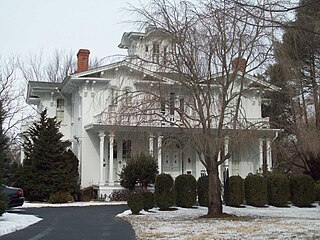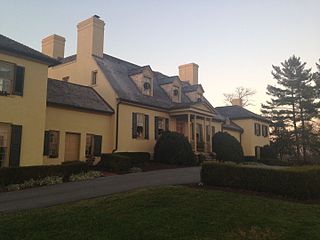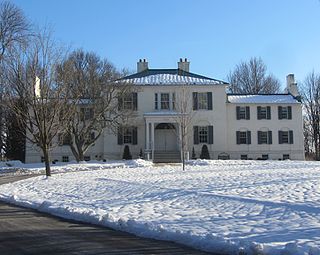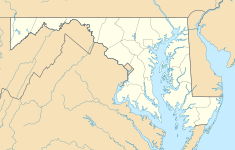
Clarksville is an unincorporated community in Howard County, Maryland; the second highest-earning county in the United States according to the U.S. Census Bureau. The community is named for William Clark, a farmer who owned much of the land on which the community now lies and served as a postal stop that opened on the 4th of July 1851.

Doughoregan Manor is a plantation house and estate located on Manor Lane west of Ellicott City, Maryland, United States. Established in the early 18th century as the seat of Maryland's prominent Carroll family, it was home to Founding Father Charles Carroll, a signer of the United States Declaration of Independence, during the late 18th century. A portion of the estate, including the main house, was designated a National Historic Landmark on November 11, 1971. It remains in the Carroll family and is not open to the public.

The Brick House on the Pike, Elerslie, Three Brothers is a historic home located at Ellicott City, Howard County, Maryland, United States. It is a large two-story, side-passage, double-pile plan house constructed in two phases, a brick structure built by Caleb Dorsey replacing a wooden structure when he bought the property at the end of the 18th century, and the larger more formal section built by his son Charles Worthington Dorsey about 1817. Also on the property and contemporary with the main house are an ice house foundation, a stone stable or carriage house and three board-and-batten outbuildings dating from the late 19th or early 20th century. The early Federal features of the house were left essentially untouched in the alterations that took place about 1907, and have remained intact. Edward Hammond undertook this modernization after being given the house as a wedding present by the father of his wife, Reubena Rogers. Electricity, central heat, and a capacious front porch were added, and the roof of the older section of the house was raised, creating a full second floor with dormer windows. Public water, sewer, gas, and modernization of utilities were accomplished between 1995 and 2009 by Dr Edward Rogers, a direct descendant of Caleb Dorsey. The previous owners, the Lassotovitch, Hammond, Ligon, and Dorsey families are all related. Governor Thomas Watkins Ligon (1810–1881) of Maryland lived in the house, having married a Dorsey, before they moved to White Hall, nearby.

Burleigh, or Burleigh Manor, or Hammonds Inheritance is a historic home located at Ellicott City, Howard County, Maryland, built on a 2,300-acre (930 ha) estate. Which included "Hammonds Inheritance" patented in 1796. It is a Federal-style brick dwelling built between 1797 and 1810, laid in Flemish bond. Based on the 1798 Tax assessment of the Elkridge Hundred, the original manor house started as a one-story frame building 24 by 18 foot in size. Also on the landscaped grounds are a 1720 stone smokehouse; a much-altered log, stone, and frame "gatehouse" or "cottage," built in 1820 as a workhouse for slaves and another log outbuilding, as well as an early-20th century bathhouse, 1941 swimming pool, and tennis court. Portions of the estate once included the old Annapolis Road which served the property until the construction of Centennial Lane to connect Clarksville to Ellicott City in 1876. The manor was built by Colonel Rezin Hammond (1745–1809), using the same craftsmen as his brother Mathias Hammond's Hammond–Harwood House in Annapolis. Rezin and his brother Matthias were active in the colonial revolution with notable participation in the burning of the Peggy Stewart (ship). Hammond bequeathed the manor and 4,500 acres (1,800 ha) to his grandnephew Denton Hammond (1785–1813) and his wife Sara who lived there until her death in 1832. All slave labor were offered manumission upon Rezin Hammonds death in 1809, with extra provisions for tools, land and livestock for thirty two slaves. The estate was owned by Civil War veteran Colonel Mathias until his death where he was buried alongside other family members on the estate. His wife Clara Stockdale Hammond maintained ownership afterward. In 1914 the estate was owned by Mary Hanson Hammond with land totaling over 1,000 acres (400 ha) including the outbuildings and slave quarters. In 1935 the Estate was subdivided to 600 acres (240 ha) and purchased by Charles McAlpin Pyle, Grandson of industrialist David Hunter McAlpin. The manor house was renovated with the great kitchen replaced by a "Stirrup Room" where meetings of the Howard County Hunt Club were performed. The house was sold in 1941 to Mrs. Anthony J. Drexel Biddle, Jr. for use of Prince Alexandre Hohenlohoe of Poland during WWII. St. Timothy's School bought the property after the war in 1946, but abandoned plans and sold to Mrs G. Dudley Iverson IV in 1950. The brick was once painted yellow, but by 1956, had almost returned to exposed red brick. As of 2013, it has operated as a livestock shelter.

Cherry Grove, located on property formerly called Fredericksburg, 400 acres patented by Orlando Griffith's oldest son Henry Griffith in 1750. Cherry Grove is a historic home and former plantation located at Woodbine, Howard County, Maryland, United States. The home is considered the seat of the Warfield family of Maryland.

Dorsey Hall is a historic home in Columbia, Maryland, United States. It is a six-by-one-bay, 2+1⁄2-story stucco structure with a gable roof covered with asphalt shingles. It is a well-preserved and detailed example of the vernacular dwellings of the early 19th century in Howard County and associated with the Dorsey family, one of the "first families" of the county.

Temora, is a historic home located at Ellicott City, Howard County, Maryland. It is a T-shaped, two-story and cupola, Tuscan-style Victorian house of stuccoed tongue-and-groove boards. The house was built in 1857 after a design prepared by Nathan G. Starkweather, a little-known but accomplished architect from Oxford, England, who also designed the First Presbyterian Church and Manse at West Madison Street and Park Avenue in the Mount Vernon-Belvedere neighborhood in Baltimore, Maryland, with his later more famous assistant - Edmund G. Lind. The house was built for Dr. Arthur Pue Jr. on land given from his grandmother Mary Dorsey Pue of Belmont Estate. The name of the estate Temora comes from the poems of Ossian

Richland Farm is a historic home and farm complex located at Clarksville, Howard County, Maryland, United States. The main house is a log and frame house, the earliest section of which is presumed to date from 1719. The main block comprises three sections, with a large addition on the rear added in 1920. It features a one-story shed-roofed wrap-around porch supported by 22 Doric order columns. Also on the property are the Overseer's/Superintendent's House, Gardener's Cottage, wagon shed, tractor shed and smokehouse with board-and-batten siding, a bank barn, a stone spring house and “Barrack.”

Troy, also known as Troy Hill Farm, is a historic slave plantation home located at Elkridge, Howard County, Maryland, United States. It is associated with the prominent Dorsey family of Howard County, who also built Dorsey Hall.

Waverly Mansion is a historic home located at Marriottsville in Howard County, Maryland, USA. It was built circa 1756, and is a 2+1⁄2-story Federal style stone house, covered with stucco, with a hyphen and addition that date to circa 1811. Also on the property are a small 1+1⁄2-story stone overseer's cottage and a 2-story frame-and-stone barn, and the ruins of a log slave quarter.

The Christ Church Guilford, historically known as the "Old Brick Church," is an historic Episcopal church located about one mile from Guilford, now part of Columbia, in Howard County, Maryland. The small Georgian church was completed in 1809. It was constructed of handmade brick laid in English garden wall brick bond with unmarked joints.

The Belmont Estate, now Belmont Manor and Historic Park, is a former plantation located at Elkridge, Howard County, Maryland, United States. Founded in the 1730s and known in the Colonial period as "Moore's Morning Choice", it was one of the earliest forced-labor farms in Howard County, Maryland. Its 1738 plantation house is one of the finest examples of Colonial Georgian architectural style in Maryland.
Font Hill Manor is a historic slave plantation in Ellicott City in Howard County, Maryland, USA. The house is situated on property surveyed by Daniel Kendall as "Kendall's Delight". The building is constructed of local granite in three sections. The first is a four-by-two bay building. The second five-by-two bay section was built in the early 1800s, which re-oriented the front entrance. A third four-by-two bay wing was added in the early 1900s.

Oakland or Oakland Manor is a Federal style stone manor house commissioned in 1810 by Charles Sterrett Ridgely in the Howard District of Anne Arundel County Maryland. The lands that became Oakland Manor were patented by John Dorsey as "Dorsey's Adventure" in 1688 which was willed to his grandson Edward Dorsey. In 1785, Luther Martin purchased properties named "Dorsey's Adventure", "Dorsey's Inheritance", "Good for Little", "Chew's Vineyard", and "Adam the First" to make the 2300 acre "Luther Martin's Elkridge Farm".
Located Glenwood in Howard County, Maryland, United States, Ellerslie Plantation.
Longwood Plantation was a forced-labor farm in Glenwood in Howard County, Maryland, United States.

Oakdale is a historic plantation located in Daisy, (Woodbine) Howard County, Maryland, former home of Maryland Governor Edwin Warfield.

Athol is a historic slave manor and rectory located in Columbia (Simpsonville), Howard County, Maryland, U.S.
Howard's Adventure is a historic slave plantation located in Gambrills, Maryland in Anne Arundel County. The historic estate was a starting point for the prominent Hammond Family of the region. The House was built by Charles Hammond after 1710. It was the home of Matthias Hammond, builder of the Hammond–Harwood House, and Colonel Rezin Hammond, builder of Burleigh Manor. The house remnants and Hammond Graveyard now site within the U.S. Naval Academy farm complex.
Wavertree or Howards Resolution is a historic home located in Glenelg, Maryland in Howard County. The estate was first surveyed as "Howard's Second Discovery" by Henry Howard in 1712. It is notable as the family seat of the prominent Iglehart family. Tilgman Iglehart built the federal style stone house in the federal style. Tilgman along with other family members are buried onsite in a family grave. The name Wavertree comes from a later owner, Colonel Leven Gale, who had ancestors in Wavertree, England. As with many pre-colonial buildings of the region, the fieldstone structure was a later addition attached to an older log structure. in 1938, the log structure section was removed from deterioration. The building was acquired in 1973 by Howard County for a park, but was returned to private ownership to Robert Watson by 1974 and Charles R. Miller Jr by 1978. The property is currently surrounded by Benson Branch Park.















